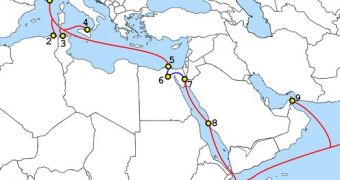We tend to think that the Internet is impossible to ‘destroy.’ It was designed initially by the US military to survive a nuclear attack. And, with billions of computers and equipment linked together, all operating pretty much independent from each other, what could possibly happen to seriously affect Internet availability on a large scale?
Well, one thing that can and does happen is the failure of underwater telecommunication cables. It happened just last week, when the SEA-ME-WE 4 submarine cable was cut, seriously disrupting communications between Europe and the Middle East and slowing the Internet to a crawl in many Arabic countries.
The cable was severed last Thursday and left ISPs scrambling to find alternative routing to provide service to their customers. But they didn't have much to go on, the cable is one of only three such cables that link the Middle East and Europe. What’s more, it provided most of the ‘lit’ capacity (the usable bandwidth), 89 percent of it, for communications between the two regions.
The source of the problem is believed to be water infiltration. The water managed to seep through and damage the cable. Repair ships were sent out to fix the problem and they should finish the job sometime today. This is not the first time communications between the two regions encountered problems due to issues with the submarine cables. Around the world, cable cuts are somewhat common, affecting millions of people when they happen.
The issue in the Middle East is about to get less critical, though, as five more cables are scheduled to be deployed this year alone. Together, they will double the bandwidth capacity between the two continents. This will bring down SEA-ME-WE 4’s importance, as it will make up only 40 percent of the lit capacity. The first two will go live next month and the rest by the end of the year.

 14 DAY TRIAL //
14 DAY TRIAL //